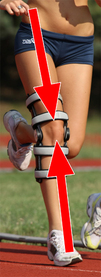protected load running recovery
In the first phase of recovery oriented to running recovery, it is advisable to use a Ktj brace to protect the knee at all stages of the running itself.
Proprioceptive or contact phase
begins with the support of the foot to the ground during which are amortized forces determined by the potential energy acquired in sinusoidal lifting of the center of gravity and those pronunced in the spine for the propulsion.
begins with the support of the foot to the ground during which are amortized forces determined by the potential energy acquired in sinusoidal lifting of the center of gravity and those pronunced in the spine for the propulsion.
In this phase , proprioceptive controls that the foot transmits to the various body segments for the maintenance of postulare balance are activated. So, brace function is mainly oriented to the absorption of compressions (to protect articular surfaces and meniscus) and acts as a
Forces Distributior to safeguard of all the articulation.
So, the brace encourages the support of the foot that allows to develop a postural balance stable for a proper dynamic action.
Kinesthetic or air phase - When the foot is not in support, the joints of the knee are not controlled by the proprioceptive system but remains subjected to the alternate accelerations on the antero-posterior plane and to the inertia determined by the accelerations to which the mass of the foot is subjected.
Moreover, the angles between thigh and leg reach their maximum closure during which the progressive and predominant slip between joints is expected.
So, in air phase, knee is subjected to kinesthetic control that elaborates stress as : motion direction, angulation between joints, acceleration , progress speed but excludes articular heads control on the dynamic relationship because they remain free to move in function of the drag determined by the acceleration forces of the peripheral masses especially at the closed angles.
In this phase Ktj brace can support the unstable knee accompanying it especially in angles of the translation , absorbing tractions determined by the alternation of oscillatory motion of the whole lower limb.
Forces Distributior to safeguard of all the articulation.
So, the brace encourages the support of the foot that allows to develop a postural balance stable for a proper dynamic action.
Kinesthetic or air phase - When the foot is not in support, the joints of the knee are not controlled by the proprioceptive system but remains subjected to the alternate accelerations on the antero-posterior plane and to the inertia determined by the accelerations to which the mass of the foot is subjected.
Moreover, the angles between thigh and leg reach their maximum closure during which the progressive and predominant slip between joints is expected.
So, in air phase, knee is subjected to kinesthetic control that elaborates stress as : motion direction, angulation between joints, acceleration , progress speed but excludes articular heads control on the dynamic relationship because they remain free to move in function of the drag determined by the acceleration forces of the peripheral masses especially at the closed angles.
In this phase Ktj brace can support the unstable knee accompanying it especially in angles of the translation , absorbing tractions determined by the alternation of oscillatory motion of the whole lower limb.



